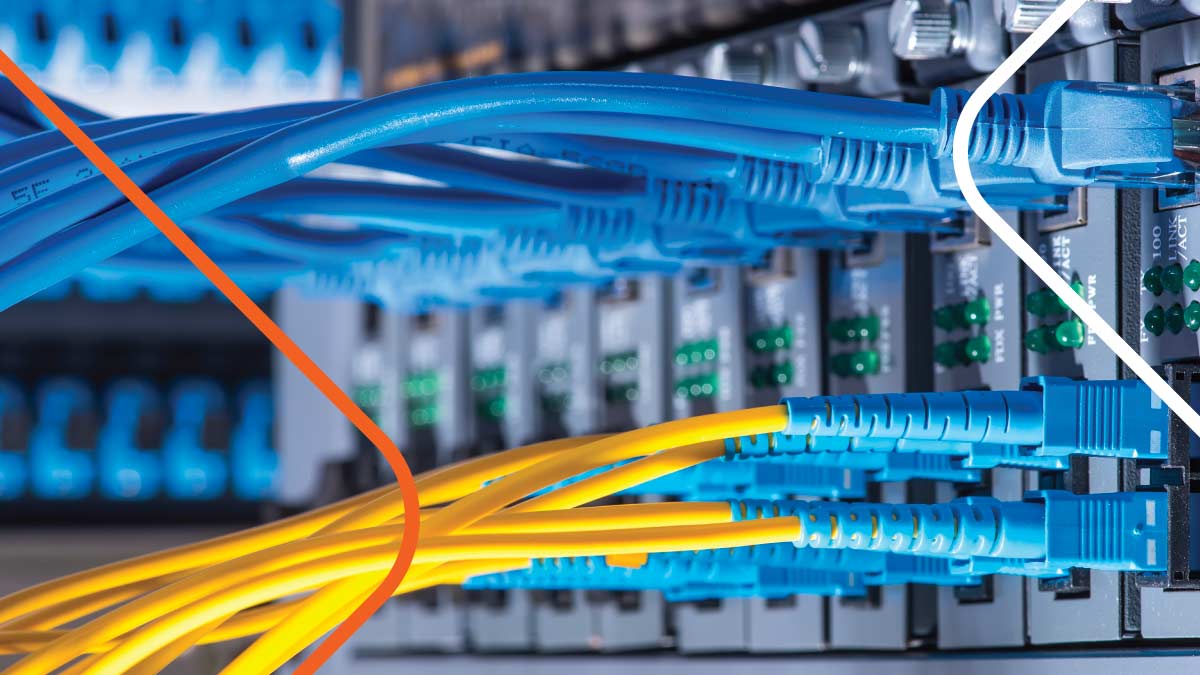A stable and secure network infrastructure is the foundation of any successful IT operation. Without a well-designed and properly implemented network, businesses may face various challenges, including communication breakdowns, data loss, and security threats. In this article, we will explore the importance of a robust network infrastructure, its components, the process of building it, and the challenges that organizations may encounter along the way.

Understanding network infrastructure
Network infrastructure refers hardware, software, and network services that enable the flow of data and information within an organization. It comprises the physical and virtual components that form the backbone of a company’s IT system.
Hardware components of network infrastructure include routers, switches, servers, and cables, which are essential for transmitting data between devices. Software elements encompass operating systems, network protocols, and security applications that manage and protect the flow of information.
Network services, such as DNS (Domain Name System) and DHCP (Dynamic Host Configuration Protocol), are vital for seamless connectivity and resource allocation within the network.
Importance of network infrastructure in IT operations
A robust network infrastructure is crucial for the smooth operation of IT systems. It facilitates efficient communication between devices, ensures data availability, and allows for the secure transmission of information.
Without a reliable network infrastructure, businesses risk experiencing frequent downtime, decreased productivity, and potentially severe financial losses.
Furthermore, a well-designed network infrastructure supports scalability and growth within an organization. By implementing redundant systems, load balancing mechanisms, and disaster recovery plans, companies can enhance their resilience to network failures and cyber threats.
Investing in advanced network infrastructure technologies, such as virtualization and software-defined networking, can also improve agility and flexibility in adapting to changing business requirements.
Components of a robust network infrastructure
Building a strong network infrastructure requires carefully selecting hardware and software elements that work together seamlessly to ensure smooth operations and data flow. Let’s delve deeper into the key components that form the backbone of a reliable network setup.
Hardware elements
Hardware elements are fundamental in a robust network infrastructure, forming the backbone of connectivity and data transmission. Hardware reliability and scalability are essential for maintaining network stability and meeting evolving operational demands. Hardware elements in a network infrastructure include:
- Routers: These devices direct traffic between different devices and networks, ensuring that data packets reach their intended destinations efficiently. Routers use routing tables and protocols to determine the best path for data transmission.
- Switches: Essential for connecting devices within a local area network (LAN), switches operate at the data link layer of the OSI model and use MAC addresses to forward data to the correct destination. They provide high-speed connectivity and efficient data transfer within a network.
- Firewalls: Safeguard the network from unauthorized access and potential security threats by acting as a barrier between internal and external networks. They inspect incoming and outgoing network traffic based on pre-established security rules to prevent malicious activities.
- Servers: Serving as the backbone of network operations, servers store and manage data, applications, and services that are essential for the functioning of an organization. Different types of servers exist, such as file servers, web servers, and database servers, each serving specific purposes.
- Network cables: The physical medium for transmitting data signals across the network infrastructure. Network cables come in various types, such as twisted pair cables, fiber optic cables, and coaxial cables. The choice of cable type impacts factors such as data transfer speed, distance limitations, and susceptibility to interference.
Software elements
Software elements play a crucial role in a robust network infrastructure by enabling efficient management, monitoring, and optimization of network resources. They facilitate seamless communication, security protocols, and adaptability to changing technological landscapes, ensuring the network’s effectiveness and resilience. Software elements in a network infrastructure include:
- Operating systems: Providing the foundational software for applications and services to run on servers and devices, operating systems manage hardware resources and provide essential functionalities. Popular operating systems include Windows Server, Linux, and Unix, each offering unique features and capabilities.
- Network management software: Crucial for efficiently monitoring, controlling, and troubleshooting network devices and performance, network management software provides administrators with tools to optimize network availability and performance. Features may include network mapping, performance analysis, and alert notifications.
- Security software: In an age of rampant cyber threats, security software is vital for protecting the network from malware, viruses, and other malicious activities. Antivirus programs, intrusion detection systems, and encryption tools are examples of security software that help fortify network defenses.
- Virtualization software: With the rise of virtualization technology, virtualization software enables the creation and management of virtual servers and networks, allowing for greater flexibility, scalability, and resource utilization. Platforms like VMware, Hyper-V, and VirtualBox are widely used for virtualizing IT environments.
Network services
Network services are essential components of a robust network infrastructure. They provide critical functionalities such as email, file sharing, and internet access. They enable seamless communication and collaboration among users while enhancing the delivery of data and resources across the network. Network infrastructure network services include:
- Domain Name System (DNS): The DNS serves as the internet’s address book, transforming human-readable website addresses into IP addresses that computers understand. This translation is essential for users to access websites and other online services using domain names.
- Dynamic Host Configuration Protocol (DHCP): DHCP simplifies network configuration by automatically assigning IP addresses to network devices when they connect to the network. This dynamic allocation streamlines network management and eliminates the need for manual IP address assignments.
- Virtual Private Networks (VPNs): Offering secure communication over the Internet, VPNs create encrypted tunnels that allow remote users to access the network securely. VPNs protect data confidentiality and integrity for remote access users by establishing a private connection over a public network.
- Internet Protocol (IP) Telephony: IP telephony enables voice and video communication over the network using IP-based technologies. Also known as Voice over IP (VoIP), IP telephony provides a cost-effective and feature-rich communication solution.

Building a robust network infrastructure
Building a robust network infrastructure is vital for seamless connectivity and reliability. It forms the foundation for efficient data transmission, effective communication, and the smooth operation of critical business processes. There are several phases in building a network infrastructure, including the following:
Planning and designing
Thorough planning and design are essential before implementing a network infrastructure. This involves assessing business requirements, considering scalability, and understanding the existing network architecture. By carefully analyzing these factors, organizations can create a blueprint that aligns with their current and future needs.
During the planning and designing phase, key stakeholders from various departments must be involved to ensure that the network infrastructure meets the needs of the entire organization. Thorough risk assessments and feasibility studies can identify potential challenges and inform mitigation strategies.
Furthermore, considering emerging technologies and industry best practices can future-proof the network infrastructure against rapid technological advancements.
Implementation and configuration
Once the planning phase is complete, the next step is to implement and configure the network infrastructure. This involves physically setting up hardware components, installing and configuring software, and establishing network connections. Proper documentation and testing should be conducted throughout this process for a seamless transition to the new infrastructure.
Collaboration between network engineers, system administrators, and cybersecurity experts is essential during the implementation phase to integrate security measures from the outset. Implementing robust access controls, encryption protocols, and intrusion detection systems can enhance the security of the network infrastructure.
Additionally, conducting thorough training sessions for IT staff on the new infrastructure can facilitate smooth adoption and operation.
Maintenance and management
Ongoing maintenance and management are crucial for the sustainability of a robust network infrastructure. Regular updates, security patches, and monitoring are necessary to promptly address potential issues. Additionally, organizations should establish comprehensive network management practices, including regular backups, network performance optimization, and troubleshooting protocols.
Implementing a proactive approach to maintenance by scheduling regular audits and performance evaluations can identify and address potential bottlenecks or vulnerabilities before they escalate. Developing a robust incident response plan and conducting regular drills can ensure the IT team is well-prepared to handle network disruptions effectively.
Moreover, fostering a culture of continuous improvement and knowledge sharing within the IT department can enhance efficiency and innovation in managing the network infrastructure.
Challenges in developing a robust network infrastructure
Challenges in developing a robust infrastructure directly impact system performance and reliability. Understanding and overcoming these challenges is essential to uninterrupted connectivity and optimal functioning of digital operations.
Security concerns
Network security is a top concern for organizations in the digital age. The increasing complexity of cyber threats, such as malware and hacking attempts, requires constant vigilance and proactive measures. Implementing robust security protocols, including firewalls, encrypted connections, and intrusion detection systems, is essential to protect sensitive data and prevent unauthorized access.
In addition to the security measures mentioned, organizations also need to stay updated on the latest security trends and technologies. Regular security audits, penetration testing, and employee training programs are crucial to maintaining strong security.
Collaborating with cybersecurity experts and participating in threat intelligence-sharing communities can provide valuable insights to enhance network security.
Scalability issues
As businesses grow and evolve, their network infrastructure must accommodate expanding requirements. Scalability is a challenge many organizations face, as adding more devices, users, and services can strain the existing infrastructure. A scalable network architecture and virtualization techniques can help organizations adapt to changing needs efficiently and cost-effectively.
Furthermore, embracing cloud technologies and software-defined networking (SDN) can enhance scalability by enabling dynamic resource allocation and on-demand provisioning. Organizations can scale their network infrastructure seamlessly in response to fluctuating demands by leveraging automation tools and orchestration platforms, supporting optimal performance and resource utilization.
Cost and budgeting constraints
Budgetary constraints often present challenges when developing a robust network infrastructure. Investing in high-quality hardware, software licenses, and network services can be expensive. Organizations must carefully prioritize their needs, allocate resources effectively, and consider long-term benefits when making investment decisions. Additionally, leveraging open-source solutions and partnering with reliable vendors can help optimize costs without compromising performance.
Moreover, conducting thorough cost-benefit analyses and total cost of ownership assessments can assist organizations in making informed decisions about network infrastructure investments. Implementing energy-efficient technologies, consolidating network resources, and exploring financing options like leasing or subscription-based services can also mitigate upfront costs and align expenses with business growth.
Adopting a strategic approach to budgeting and cost management can help organizations build a resilient network infrastructure that meets current and future requirements.
Conclusion
A robust network infrastructure is the backbone of IT operations, enabling efficient communication, data availability, and secure information exchange within organizations. Understanding the components of a network infrastructure, planning and designing an effective system, and addressing challenges like security, scalability, and cost are crucial for businesses to establish and maintain a stable and reliable network infrastructure. By investing in a robust network infrastructure, organizations can enhance productivity, protect sensitive data, and adapt to future technological advancements.
Ready to strengthen your IT operations? Schedule an introductory call with Field Nation today and find out why we’re the most convenient solution for connecting with thousands of skilled IT field service technicians.







